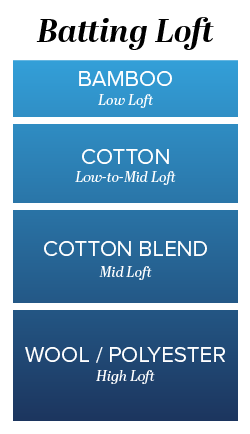6 Kinds of Batting and When to Use Them
A quilt sandwich has three parts:
- The quilt top: the part of the quilt where all the piecing magic happens.
- The batting: the fluffy material that goes between your quilt top and backing.
- The backing: the fabric that makes up the backside of your quilt.
Batting isn't flashy, but it impacts your quilt's outcome in several important ways.
Things to Consider When Choosing Your Batting
What do you want to be the star of the show, your piecing or your quilting?
Thick batting emphasizes the pattern you stitch into your quilt, while thin batting helps it fade into the background.
"Loft” is batting thickness. High-loft batting is thick, and low-loft batting is thin.
High-loft batting shines a spotlight on your quilting. Low-loft is perfect for showcasing your piecing.
Consider how far apart your stitches will be. Some batting uses scrim: a stabilizer that stops the fibers from separating or stretching.
Adding scrim to batting makes it a lot thicker. This isn't a concern if you machine quilt with a sewing machine or longarm. For hand quilters, though, scrim batting is too thick to be practical.
Do you want to snuggle up with your quilt in the winter or use it as a light summer throw?
This one’s a little dependent on loft too, but breathability is even more important. Cotton batting breaths better than polyester, so if you’re looking for a lightweight blanket, go cotton. Polyester is perfect for that cozy mid-winter blanket.
Do you prefer a thick, heavy look, or a thin, light look?
Low-loft batting is a good choice for wall-hangings, table décor, or quilted clothing like jackets or dresses. High-loft batting is great for traditional quilts that you plan to use as blankets.
Drape can also contribute to the look of the quilt. This simply refers to the way the batting hangs—if it’s soft or stiff. That drape will determine how your quilt drapes as well.
The Many Different Types of Batting
To choose the best batting for your quilting project, make sure you understand the differences between batting materials.
Cotton
This all-natural batting manages to be breathable, comfortable, and warm all at the same time. With its soft feel and flowy draping, cotton batting is a reliable option for almost any quitling project.
Cotton batting tends to be lower loft, so quilts made with it come out relatively thin and lightweight.
If your quilt uses a lot of white or light-colored fabric, opt for the white or bleached batting. Light-colored fabrics show the color of the batting underneath, so natural batting yellows the appearance of the quilt.
The shrink factor is another vital component to picking the right batting for your quilt. Cotton shrinks when washed, so if you don’t prewash your batting, your quilt will have a crinkly, lived in look. Some quilters love that—but if you don’t, you can just prewash your batting to avoid it.
ANGELIQUE’S FAVORITE: Right now, Angelique is quilting with 100% cotton, because she goes where a good sale takes her. Usually, she prefers an 80/20 blend. It doesn’t shrink as much as cotton, but it still has the same nice feel with low-to-medium loft. If she’s looking to make a puffy children’s blanket though, it’s polyester all the way.
Polyester
Polyester batting is synthetic, so it is more affordable than natural batting options. Polyester is perfect for puffy quilts and winter blankets because of its high loft. High-loft batting also helps emphasize quilted stitching, so polyester is a good way to go for that.
The durability of polyester makes it a favorite for tied quilts. Unlike some softer battings, polyester is strong enough to handle the large spaces between quilt ties. That same sturdiness gives polyester a stiff, heavy look, though, so you won't get soft, flowy look of cotton-batting quilts.
Polyester doesn’t breathe well, so make your next bed quilt with a different batting if you sleep hot!
With little to no shrink-factor, you don’t have to worry about your quilts crinkling after you wash them.
Cotton Blends
If you haven’t heard of a cotton blend batting, you’ve probably heard of an 80/20 blend. Most quilters settle into a cotton-poly blend, because it offers all the benefits of cotton and polyester batting. Get the soft, breathable qualities of cotton with the low-stretch warmth of polyester.
JENNA’S FAVORITE: Jenna loves quilting with an 80/20 cotton blend because it is warm and breathable but not too bulky.
SABRINA’S FAVORITE: Sabrina loves 80/20, too, but it has to be bleached! She loves white quilts, and white batting ensures that she doesn’t get any yellowing when she makes her quilt sandwich. Her biggest batting tip, though, is using a nice blanket (she usually gets hers at Sam’s Club or Costco) instead of batting. It’s more affordable, and sometimes she doesn’t even have to use backing.
Wool
Wool batting is soft and flowy like cotton, but it has a higher loft, so it's a natural substitute for polyester. Wool batting shrinks like cotton, though, so keep that in mind.
If you make your quilt top or backing from thin fabrics, wool fibers can poke through. These scratchy surprises make snuggling up in your quilt an itchy, less-than-pleasant experience.
Bamboo
Bamboo is as lightweight as batting gets. This soft, thin option is a go-to for baby quilts. Bamboo batting is the most eco-friendly option on the market. Unfortunately, it’s also one of the more expensive batting options.
Find Your Favorite Batting, One Quilt at a Time
Finding your favorite batting can’t happen if you don’t experiment! Try them all and figure out what you like best. We can tell you all about our favorites, but personal preference is the biggest, most important factor.
Quilt however you want! There’s no wrong answer as long as you’re making quilts you love and having a blast doing it!
Posted by The Grace Company
For over 25 years the Grace Company has been the leading manufacturer of high quality quilting frames and quilting accessories. What truly sets The Grace Company apart from other competitors is its level of quality, value, and experience toward all their endeavours. From products to external and internal customer experience, the Grace Company responds to market and customer needs and continues to lead the quilting industry. Grace Company frames and hoops are designed to be easy to build and compatible with most major quilting machines. They'll have the quilting product you need.




